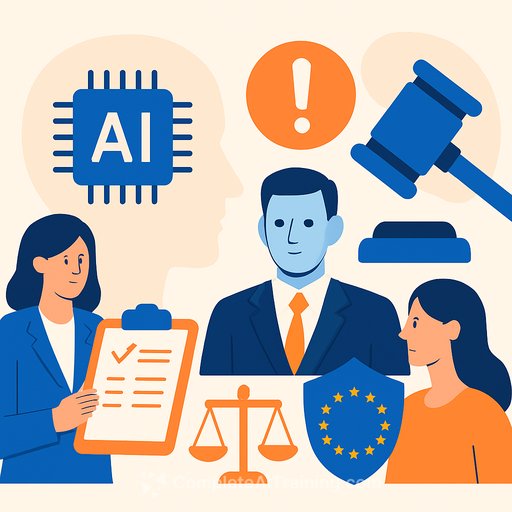AI in HR: Practical Ways to Enhance Practice and Reduce Risk
AI has moved into core HR workflows. In Ireland, more than one in four employers already apply it in recruitment. The upside is speed and consistency. The risk is legal exposure if you let systems decide without guardrails.
HR remains the buffer between automation and fairness. Below is a practical guide to where AI fits across the employment cycle, the legal risks at each stage, and how HR can keep the process compliant and human.
1) Recruitment
AI can draft job ads, suggest pay ranges, screen CVs, generate assessments, contact candidates and schedule interviews. That convenience comes with exposure under the Employment Equality Acts 1998-2015 and the EU AI Act.
Selecting and assessing candidates
- Run bias checks on CV screening. If a tool keeps surfacing similar profiles (e.g., by age, gender, or school), stop and review the inputs and filters.
- Scrutinise assessments. Ask: "Could this task or phrasing advantage a particular group?" Adjust or replace if it does.
- Watch training data. If your historic hires skew male or from one university, that preference can seep into model outputs. Reset criteria to job-relevant skills and outcomes.
- Maintain human review for shortlists. AI suggests; HR decides.
Setting pay or pay ranges
- Prepare for the EU Pay Transparency Directive. Use gender-neutral language in ads and be ready to disclose pay or pay ranges in line with Irish transposition by June 2026.
- If AI proposes pay, document the rationale. Compare against existing employees in the same category by gender and record the objective reasons for differences.
- Keep a single source of truth for ranges, and have HR validate any variance before an offer is made.
Overseeing the use of AI (Recruitment)
- Recruitment AI is treated as high-risk under the EU AI Act. Inform candidates when AI is used and ensure staff using these systems have sufficient AI literacy.
- Keep audit logs: what the tool did, what humans decided, and why. Store prompts, criteria, and version history of any models or templates used.
2) Performance Appraisals and Management
AI can summarise performance data, draft feedback, propose goals, and flag low or high performers. Use it to speed admin, not to replace judgement.
Setting pay on promotion
- Expect to justify pay decisions if a gender pay gap of more than 5% appears within a worker category under the Pay Transparency Directive.
- Have HR support managers with a consistent framework: role scope, market data, internal equity, and documented reasons.
Reviewing performance
- Scan AI-generated summaries for loaded or vague phrases. Replace "bad cultural fit" with specific, job-related feedback tied to documented expectations.
- Keep feedback factual, current, and anchored in evidence the employee has seen.
Managing performance
- AI can help spot trends, but the process must follow your handbook. The WRC will look at the reasonableness of actions, not whether "the system said so."
- Provide procedural fairness: clear expectations, support, timelines, and an opportunity to respond.
Overseeing the use of AI (Performance)
- Using AI to inform work-related decisions falls into high-risk territory under the AI Act. Let employees know when AI is part of the process and keep a human in the loop.
3) Grievances and Interpersonal Issues
AI can help schedule, analyse documents, take notes, and draft reports. But the first contact should be human. The Safety, Health and Welfare at Work Act 2005, and the bullying/harassment Code of Practice, expect a real person to act as a contact for "supportive listening and information provision."
Receiving grievances
- HR should be the first touchpoint. Maintain confidentiality, triage the issue, and guide the process.
- Use AI to detect trends (e.g., hotspots for bullying or harassment) to meet your duty to manage psychosocial risks.
Investigations
- AI can draft timelines or structure evidence, but investigators should test assumptions and verify facts.
- Assume your investigation could be reviewed by the WRC. Keep notes, rationale, and decisions crisp and defensible.
Overseeing the use of AI (Grievances)
- If AI supports case management, disclose its use where employees interact with it. Ensure human oversight on every material step.
4) Disciplinary Action
Decision-making belongs to people. AI may surface patterns or inconsistencies, but it cannot be the decision maker for warnings or termination.
- The decision maker's reasoning will be examined in unfair dismissal or discrimination claims. Keep the paper trail clear and human-authored.
- HR's role: coach on process, ensure proportionality, and confirm evidence supports the outcome.
Your Compliance Guardrails
- Bias controls: pre-deployment testing, periodic sampling, and adverse-impact analysis on protected characteristics.
- Human oversight: documented checkpoints where HR reviews and can override AI outputs.
- Data hygiene: use job-relevant, up-to-date data; remove proxies for protected traits; set retention limits.
- Transparency: inform candidates and employees when AI is used in high-risk HR contexts and how humans remain accountable.
- Record-keeping: store prompts, criteria, change logs, and decision notes. If you can't explain it, don't deploy it.
- AI literacy: train HR, recruiters, and managers on smart use, risk spotting, and corrective actions.
Key Laws to Keep Front of Mind
- Employment Equality Acts 1998-2015: prohibits discrimination across nine protected characteristics.
- EU AI Act: classifies many HR systems as high-risk and expects transparency, oversight, and competent users. Read the regulation.
- EU Pay Transparency Directive: disclosure of pay or pay ranges and justification of gaps above 5% by objective reasons. Read the directive.
- Safety, Health and Welfare at Work Act 2005 and Code of Practice: require a safe workplace and a human contact for bullying/harassment concerns.
Quick HR Checklist
- Recruitment: bias-check screens and assessments; disclose AI use; document pay logic; use gender-neutral language.
- Performance: rewrite AI drafts for clarity; keep feedback job-specific; follow policy in every step.
- Grievances: first contact is human; use AI for admin and trend insights; preserve evidence and decisions.
- Discipline: AI informs, people decide; keep reasons clear and proportionate; ensure fairness.
- Governance: assign owners, set review cadence, and train your team on AI literacy.
Build Your Team's AI Literacy
If your HR team needs practical training on prompts, guardrails, and policies, explore role-specific options here: AI courses by job.
Important: This article provides general information and is not legal advice. Get specialist advice for your specific situation.
Your membership also unlocks:






